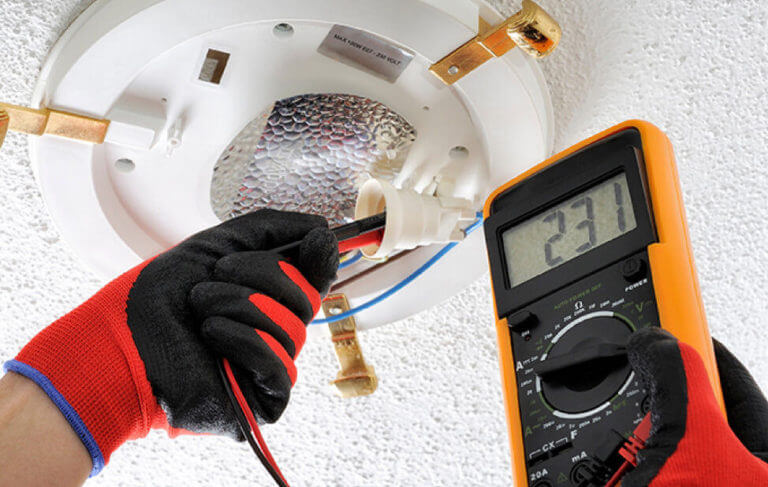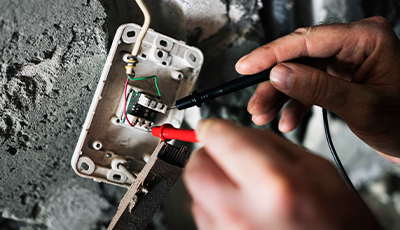Typical Electrical Troubles Every Property Owner Must Learn about
Property owners usually encounter various electrical issues that can affect security and functionality. Issues like flickering lights and tripped breaker are a lot more typical than several understand. These situations can show deeper electrical worries that warrant attention. Understanding the dangers and signs related to out-of-date wiring and dead electrical outlets is essential. What measures can be required to protect against these problems? Checking out these common electric concerns can reveal important insights for preserving a safe home atmosphere.

Flickering Lights: Causes and Solutions
Why do some home owners experience flickering lights? Flickering lights can be an usual nuisance, commonly indicating underlying electrical concerns. One primary reason is loose or faulty connections within lights or wiring, which can cause periodic power supply. Additionally, making use of high-wattage devices on the exact same circuit might trigger voltage variations, leading to flickering or lowering. An additional potential concern is an overloaded circuit, where way too many devices draw power all at once, straining the electric system. Outdated or abject circuitry can add to irregular electric flow. Sometimes, flickering lights may signal an issue with the home's electrical panel or service line. Homeowners should resolve flickering lights without delay to avoid possible threats. Solutions may include tightening up links, redistributing device tons, or getting in touch with a certified electrician for a complete analysis. Determining the origin cause can help ensure a secure and safe electric system in the home.
Tripped Circuit Breakers: What You Required to Know
Have house owners ever before wondered what causes their circuit breakers to journey all of a sudden? This typical problem often occurs from an overload of electric circuits, where a lot of gadgets attract power simultaneously. In such situations, the breaker works as a safety device, disrupting the circulation of electricity to prevent getting too hot and potential risks. One more regular cause is a short circuit, which happens when a real-time wire calls a neutral wire, producing a rise of electricity that journeys the breaker. Ground faults can additionally bring about stumbled breakers; these take place when a live cord touches the ground or a grounded surface area, posing significant security threats. Property owners ought to on a regular basis assess their usage of high-wattage home appliances to avoid overloading circuits. Furthermore, comprehending the feature of breaker can help them react appropriately throughout a trip, ensuring their home continues to be secure and well-maintained.
Outdated Electrical Wiring: Dangers and signs
Outdated electrical wiring can posture substantial dangers to house owners, typically going undetected up until issues develop. Homes developed prior to the 1980s might still have aluminum circuitry or knob-and-tube systems, which are no more taken into consideration safe. Indicators of outdated circuitry include flickering lights, regularly stumbled circuit breakers, or burning smells near outlets. These indications may suggest that the electric system is overloaded or deteriorating.Additionally, property owners could observe swelter marks around outlets or switches, which can indicate getting too hot. The risk of electric fires substantially enhances with obsolete wiring, as these systems were not designed to handle modern-day electric loads. Home owners are urged to have their electrical wiring evaluated regularly, particularly when restoring or including new devices. By acknowledging these indicators early, they can stay clear of hazardous circumstances and maintain a more secure living environment. Updating to present electric standards is a proactive action in preserving home safety and security and performance.
Regularly Blown Fuses: Fixing Tips
Frequent blown merges can suggest underlying electrical concerns that might originate from obsolete electrical wiring or overloaded circuits. Home owners experiencing this issue needs to first identify the devices linked to the influenced circuit. It is suggested to avoid making use of several high-wattage tools simultaneously, as this can lead to circuit overload. If the problem persists, inspecting the fuse box for indicators of wear or damage is critical; a malfunctioning fuse box may need replacement.Additionally, examining for loose connections within the circuit can aid protect against future occurrences. Property owners need to additionally verify that the fuses being utilized are of the right amperage, as utilizing an incorrect fuse can worsen the problem. If these fixing pointers do not deal with the concern, getting in touch with an accredited electrical contractor is advised to assess the electrical system better. Attending to these issues promptly can aid minimize dangers and assure the security of the home's electrical framework.
Dead Electrical Outlets: Typical Reasons and Repairs
When a home owner experiences a dead outlet, it can usually be a source of irritation and complication. Several usual reasons may bring about this problem. One constant offender is a tripped breaker, which can be conveniently reset. If any type of breakers are in the off position, homeowners ought to next evaluate their electric panel to inspect. Another possibility is a malfunctioning outlet itself, which may call for replacement. In addition, loosened circuitry connections within the outlet can interrupt power flow, making examination essential.Sometimes, the trouble may originate from an overloaded circuit, especially when several tools are attached. In such cases, redistributing the electric tons can fix the concern. Property owners must also think about the age of their wiring; older systems may call for updates to satisfy modern electric demands. If these actions do not fix the scenario, getting in touch with a qualified electrician is advisable to ensure security and correct diagnosis.
Electrical Shocks: When to Be Worried
Just how can house owners determine whether an electrical shock warrants problem? House owners must initially evaluate the extent and context of the shock. A moderate static shock, usually really felt when touching steel objects, is usual and generally safe. If the shock takes place while connecting with a plugged-in device or electrical outlet, it might suggest an extra severe issue.The location and frequency of the shocks are necessary. Repetitive shocks from the exact same resource, especially in wet locations like washrooms or kitchen areas, might signal damaged wiring or inadequate grounding. Homeowners must also take into consideration the feeling of the shock; a jolt that creates discomfort or muscle contractions is extra disconcerting than a mere tingle.If there's any kind of unpredictability, it is advisable to speak with a certified electrician. Overlooking prospective electrical threats can bring about major security dangers, consisting of fire or serious injury.
Overloaded Circuits: Prevention and Precaution
Overloaded circuits posture substantial risks in property setups, often resulting in electric fires or equipment damage (ASP Level 2 Electrician). Property owners need to identify the indications of an overloaded circuit, such as often tripped breakers or lowering lights. Implementing precautionary safety practices can help minimize these dangers and guarantee a much safer living atmosphere
Acknowledging Overloaded Circuits
What indications suggest that a circuit may be strained? Homeowners must be cautious for a number of vital signs. Frequently stumbled circuit breakers or blown merges recommend too much load on the circuit. Lowering or flickering lights, specifically when various other appliances are in use, can represent an insufficient power supply. Furthermore, electrical outlets or buttons that feel cozy to the touch may suggest overheating, a potential fire risk. Unusual humming sounds from outlets likewise necessitate interest, as they can indicate electrical issues. Finally, if home appliances run inefficiently or fail to start, it might signify an overloaded circuit. Acknowledging these indicators early can aid stop severe electrical troubles and promote a much safer home atmosphere.
Preventive Safety Practices
To keep a reliable and safe electrical system, homeowners have to carry out precautionary safety methods that deal with prospective circuit overloads. One reliable measure is to prevent connecting too numerous tools to a single electrical outlet, as this can exceed the circuit's capacity. Making use of power strips with built-in circuit breakers can aid distribute power securely. Homeowners need to additionally regularly examine cables and home appliances for damages and change any kind of damaged devices without delay. It is essential to assure that check this circuit breakers are operating correctly and to be conscious of the total electrical power being made use of in each circuit. Additionally, seeking advice from a qualified electrical expert for periodic inspections can recognize potential concerns prior to they escalate, guaranteeing a safer living setting and prolonging the life expectancy of electric systems.
Often Asked Concerns
Exactly how Typically Should I Have My Electric System Inspected?
Routine inspections of electrical systems are suggested every 3 to 5 years. Property owners ought to think about much more regular checks if they experience concerns, embark on renovations, or live in older residential or commercial properties to assure security and compliance.
Can I Fix Electric Troubles Myself or Hire a Specialist?

What Are the Signs of an Electric Fire Threat?
Indicators of an electrical fire danger include frequently tripped breaker, flickering lights, melting odors, blemished outlets, or cozy, humming cables. Homeowners ought to stay vigilant and seek professional help if any of these indications exist.
How Do I Know if My Home Requirements an Electric Upgrade?
To establish if a home requires an electrical upgrade, indicators consist of frequent circuit breaker journeys, out-of-date wiring, not enough outlets, flickering lights, and the presence of older electric panels, showing prospective security dangers and ineffectiveness.
Are There Details Safety Tips for DIY Electrical Job?
When considering do it yourself electric work, one ought to constantly transform off power, utilize insulated devices, verify circuit performance, adhere to local codes, and consult specialists for intricate tasks to ensure safety and stop crashes. An additional possible problem is an overloaded circuit, where also numerous devices attract power all at once, straining the electrical system. The threat of electrical fires markedly boosts with out-of-date wiring, as these systems were not developed to take care of modern-day electrical loads. Regular blown integrates can show underlying electrical issues that might stem from out-of-date wiring or overloaded circuits. To maintain a safe and reliable electrical system, property owners must apply precautionary security techniques that resolve prospective circuit overloads. Accredited Service Provider Level 2 Electrician. Indications of an electric fire threat consist of often stumbled circuit breakers, flickering lights, melting smells, stained electrical outlets, or cozy, humming wires